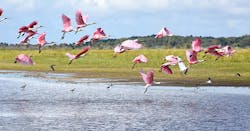Earth Day Update: Everglades Restoration Taking Wing
Those of us who live, work, and play in South Florida recently received some good news – just in time for Earth Day – from the South Florida Water Management District (SFWMD).
In its latest South Florida Wading Bird Report, SFWMD reported that in 2021, these feathered friends (e.g., herons, egrets, spoonbills, and ibis) had nested in the Everglades in their largest numbers in eight or nine decades!
SFWMD is a regional governmental agency that manages the water resources in the southern half of the state for some 9 million residents. It covers 16 counties from Orlando to the Keys, and is driving the restoration of the Everglades, the largest environmental restoration project in U.S. history.
So the good news is not just relevant to Floridians since the Everglades is important to all of us.
According to the report, “An estimated 101,794 wading bird nests (excluding Cattle Egrets [CAEG], which do not rely on wetlands) were initiated in South Florida during the 2021 nesting season (Dec. 2020 to July 2021). This is the second largest annual nesting effort observed since comprehensive systemwide surveys began in South Florida in 1996 and is comparable with reports of large nesting events from the 1940s. The 2021 nesting season is over double the 10-year average (48,328.8 nests), but falls short of the previous banner nesting season of 2018 (138,834 nests) by 37,040 nests.”
These nests are particularly significant, since they reflect the overall health of the Everglades and the continuing success of the more than 50 various Everglades projects either begun or completed since 2019. Because wading birds require the right combination of wet and dry conditions in order to breed, their nesting directly reflects the improvement in the Everglade’s complex water flow patterns. Those patterns were disrupted by draining in the early 20th century, for housing and agriculture, and later for flood control efforts, prompted by hurricanes, that had reduced the wetlands by some 40%.
This January, in order to ensure that these successful projects continue, Florida Gov. Ron DeSantis signed Executive Order 23-06 (Achieving Even More Now for Florida’s Environment) to “enhance ongoing efforts to expedite restoration projects and further advance the protection of Florida’s natural resources.” These efforts, part of Florida’s partnership with the U.S. Army Corps of Engineers – Jacksonville District, and Florida’s unprecedented state funding, are making a demonstrable difference in restoring a vital ecosystem – the largest such program in U.S. history!
Happy Earth Day!
##########
A regular contributor to HPAC Engineering and a member of its editorial advisory board, the author is a principal at Sustainable Performance Solutions LLC, a south Florida-based engineering firm focusing on energy and sustainability. He can be reached at [email protected].
About the Author
Larry Clark
A member of HPAC Engineering’s Editorial Advisory Board, Lawrence (Larry) Clark, QCxP, GGP, LEED AP+, is principal of Sustainable Performance Solutions LLC, a South Florida-based engineering firm focused on energy and sustainability consulting. He has more than two dozen published articles on HVAC- and energy-related topics to his credit and frequently lectures on green-building best practices, central-energy-plant optimization, and demand-controlled ventilation.
